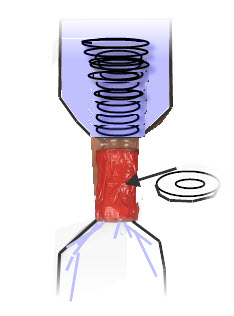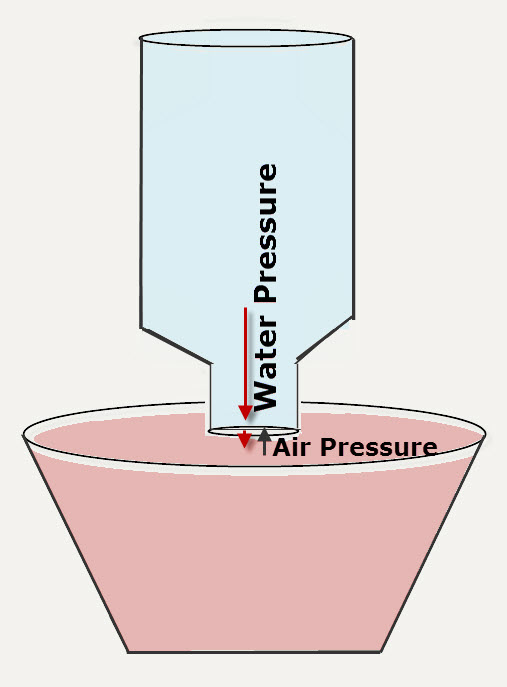Turn a water filled bottle upside down. Hold the bottle vertical over a container to catch the water coming out of the bottle. When the water leaves the bottle an empty space is left at the top.
The amount of water coming out has to be replaced by something else because liquids do not expand or contract very much when the pressure changes.
If the bottle is plastic, as the water exits the bottle the pressure inside decreases. Instead of leaving a vacuum space, the walls of the bottle will be pushed in by air pressure outside the bottle.
Once this has happened, or if a glass bottle is used, air from outside the bottle enters to fill the empty space created when the water leaves.
The water exiting and air entering have to take turns, which produces a glug-glug effect. Bubbles of air enter, then some water exits.
How can the rate at which the water exits the bottle be increased?
1. What effect does the amount of air inside the bottle affect the rate at which the water flows out? Fill the bottle about three-fourths full with water. Then, quickly invert the bottle over the bowl. Make sure the bottle is vertical.
FACT: Air can expand to fill the vacuum produced when water leaves the bottle. When the pressure inside the bottle pushing down is equal to the air pressure outside the bottle pushing up is equal, then any further loss of water starts the glug-glug process with air going in, then water going out.
2. What effect does the angle of the bottle have on the rate the water exits the bottle?
If you hold the bottle at an angle, there is an air passage in the neck of the bottle. Air can continue to come in while water continues to exit. There is no glug-glug effect.
3.What effect does swirling the bottle have on the rate that water moves out of the bottle?
Fact: Swirling the bottle causes the water to move to the outside of the neck of the bottle leaving an opening for a column of air to enter up the center. As long as the water swirls, air comes up through the center replacing the water that flows out.
Flow is fastest when the bottle is full, because this is when there is greatest pressure pushing the water outof the mouth of the bottle.
4. What effect does swirling and holding the bottle at angle have on the rate that the water pours out of the bottle?
Swirling and holding the bottle at an angle increases the rate the water exits.
——————————
Two slow the water exit so that you can better time the exit of the water, use two 1-liter soda bottles. Fill one bottle with water. Place a metal washer over the mouth of this bottle. Then turn the second bottle upside down so the mouths of the bottle fit with the washer between them.
Use duct tape to secure the two bottles together. Turn the bottles over so that the water filled bottle is on top. Go through each of the previous steps to determine how each variable affects the water’s exit rate.

Time the exit of the water. Determine how the volume of the water in the bottle affect the rate the water exits the bottle. Do this by marking the bottle into equal thirds. Measure the time it take for each 1/3 of the water to exit.
Result Expected:
As the volume of water in the bottle decreases the time it takes for the water to exit increases. (Think about it. The more water the greater is the pressure pushing the water out the opening.)
Repeating the experiment, with the bottle at an angle. As before the as the volume of the water in the bottle decreases the time it takes for the water to exit increases. But each time measured is less than when the bottle is held vertically.
Swirling the bottle also increases the rate the water leaves the bottle, but again, as the water in the bottle decreases, the time it takes for the water to exit increases.
Dividing the volume of water in the bottle into equal thirds, the first, second, and third volumes left the inverted bottle in 2.5, 3.5, and 3.8 seconds; the angled bottle in 2.0, 2.4, and 3.7 seconds, and the swirling bottle in 2.0, 2.3, and 3.3 seconds.
The swirling technique, although very smooth once perfected, is not recommended for high-speed pouring of beer or any drink containing gas.
